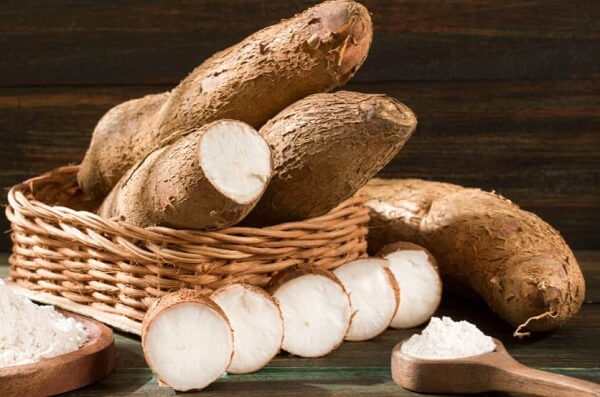Vietnam Ranks Third In Cassava Exports Over The World
Vietnam Cassava is the world’s third largest quantity of cassava and cassava products in terms of output, after Thailand and Cambodia, and second in export turnover after Thailand. Diversifying markets, taking advantage of opportunities to enjoy tariff quotas from free trade agreements (FTAs) will be the solution to help this industry expand export markets.

Vietnam Cassava Export mainly to China market
According to the General Department of Customs, in 2021, Vietnam Cassava exports will reach nearly 2.9 million tons, worth nearly $1.2 billion, up 2.4% in volume and 16.5% in value compared to 2020. Vietnam Cassava and cassava products is one of the agricultural products that still maintained the growth rate in both output and export turnover in the past year.
In the first months of 2022, after the decline in export turnover in January and February, the export of cassava and cassava products in March tended to increase again. According to estimates, in March 2022, the export of cassava and cassava products reached about 450 thousand tons, worth 202 million USD, up 80.6% in volume and 97.1% in value compared to February. 2022; compared to March 2021, an increase of 51% in volume and 79.1% in value.
Accumulated in the first 3 months of 2022, the export of Vietnam Cassava and cassava products is estimated at about 970 thousand tons, worth US$ 420 million, down 0.6% in volume, but increasing by 15.5% in value compared to the previous 3 months. same period in 2021.
However, this industry is still very much existing. The technology in many factories, especially small factories with medium technology level, is even outdated, environmental treatment has not been focused, leading to low investment efficiency, waste and impact on the environment. school. There are not many cassava varieties with high yield, good quality, high starch content and resistance to cassava leaf mosaic disease;…
Currently, Vietnam Cassava and cassava products are one of 13 key agricultural products for export of Vietnam and the third largest exporter of cassava and cassava products in the world in terms of output after Thailand, Cambodia and second. The world in terms of export turnover is only after Thailand.
From a market perspective, Mr. Nguyen Quoc Toan – Director of the Department of Agricultural Products Processing and Market Development (Ministry of Agriculture and Rural Development) – said that the coordination between the factory and cassava farmers is not tight. closely, both in terms of mechanisms and benefits. Some processing plants do not have an association contract and organize the production of raw materials, so they do not have enough raw materials to operate.
The purchasing method and price are not flexible, which has not created a motivation to encourage farmers to grow cassava, especially in the areas near the factory. Unstable export prices, weak export markets, dependence on foreign countries; lack of protection policies for cassava farmers in remote areas.
Notably, the cassava market has many intermediary stages, each stage has many actors involved, so the market is quite complicated, with fierce competition to buy and sell. The market is speculative, price competition leads to the result that the gap between farmers’ purchasing prices and consumption prices increases, and intermediaries benefit.
The export market of cassava and cassava products is still limited, mainly depends on the Chinese market, accounting for over 95% of the total output of cassava and cassava products and increasingly facing fierce competition from Thailand. , Cambodia and Laos. Depending almost entirely on the Chinese market, this leads to unsustainability, and passivity.
Meanwhile, national competition is low because Vietnam’s market for cassava and cassava products has many intermediaries, and Vietnam’s logistics costs are higher than that of Thailand and China.
Another paradox raised by Mr. Nguyen Nhu Cuong – Director of the Department of Crop Production (Ministry of Agriculture and Rural Development) is that domestic consumption of cassava and cassava products accounts for about 30% of the total cassava production used for food processing. animal feed, animal feed, input materials for industry, production of alcohol, monosodium glutamate, instant noodles, liquid sugar, modified starch, confectionery. Meanwhile, we have to import quite a lot of raw materials for animal feed processing, raw materials used in the food processing industry.
Diversify the market
According to the forecast of the Import-Export Department (Ministry of Industry and Trade), in 2022, China will have an even greater import demand for cassava and will import more than Vietnam Cassava and cassava products due to geographical conditions. favorable. However, the export of cassava and cassava products to China in the near future will face many difficulties because of a series of new regulations and standards issued and applied by the General Administration of Customs of China from the beginning of 2022.
Currently, Vietnam Cassava and cassava products are mainly exported to the Chinese market, however, more than 65% of export output is in the form of delivery at the border, through border gates in Lang Son, Quang Ninh, Lao Cai.
From January 1, 2022, China has become a member of the Regional Comprehensive Economic Partnership (RCEP), so exported products that do not meet the standards of the RCEP member markets will not be eligible. not only facing the loss of the market but also the risk of affecting an entire manufacturing industry.
The Import-Export Department recommends that cassava exporters strongly switch to official export. On the other hand, it is necessary to review the planning of growing areas and reorganize production so that Vietnamese products must be clean products, meeting market criteria, especially in the context of the upcoming implementation of the project. official export; continue to expand the market, improve the quality and value of Vietnam Cassava products.
In addition to maintaining the traditional market of China, Mr. Nguyen Quoc Toan said that it is necessary to focus on markets with large import demand for cassava such as Korea, Japan, and Taiwan.
Notably, according to the signed EU-Vietnam Free Trade Agreement (EVFTA), tapioca is a product granted tariff-free quota, ranking second after rice at 30,000 tons/year (export tax). cassava starch outside the quota is 166 EUR/ton; fresh cassava roots, sliced frozen cassava or not outside the quota for tax calculation is 9.5 EUR/kg).
Currently, Vietnam Cassava industry has not taken advantage of the above opportunities to expand export markets to countries and regions that have signed FTAs to take advantage of opportunities to enjoy tariff quotas and expand export markets. cassava and cassava products from Vietnam.
Therefore, promoting exports to the EU market in particular, the markets of regions that have signed FTAs to take advantage of tariff quotas and expand the export markets of Vietnam Cassava and cassava products are also recommended by experts.
https://cassava-wholesale-supply.blogspot.com/2022/08/vietnam-ranks-third-in-cassava-exports.html
